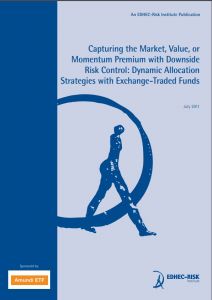

Capturing the Market, Value, or Momentum Premium with Downside Risk Control: Dynamic Allocation Strategies with Exchange-Traded Funds
There is extensive evidence that investment strategies based on momentum and value are attractive for portfolio managers who seek higher performances. Momentum and value are among the most robust return drivers in the cross section of expected returns. Dynamic risk budgeting methodologies such as Dynamic Core Satellite strategies (DCS) are used to provide risk-controlled exposure to different asset classes. We examine how to exploit the value and momentum anomalies using a DCS investment model. This paper shows that the DCS approach can boost portfolio returns while keeping downside risk under control.
Author(s):
Summary:
There is extensive evidence that investment strategies based on momentum and value are attractive for portfolio managers who seek higher performances. Momentum and value are among the most robust return drivers in the cross section of expected returns. Dynamic risk budgeting methodologies such as Dynamic Core Satellite strategies (DCS) are used to provide risk-controlled exposure to different asset classes. We examine how to exploit the value and momentum anomalies using a DCS investment model. This paper shows that the DCS approach can boost portfolio returns while keeping downside risk under control. The implementation of the portfolio strategies is enabled by exchange-traded funds which are natural investment vehicles since they offer a broad exposure to the markets and provide the necessary liquidity to the frequent rebalancing of the DCS model.
Register to download PDF
Register/Log in| Type : | EDHEC Publication |
|---|---|
| Date : | 07/08/2011 |
| Keywords : |
Risk Management |

